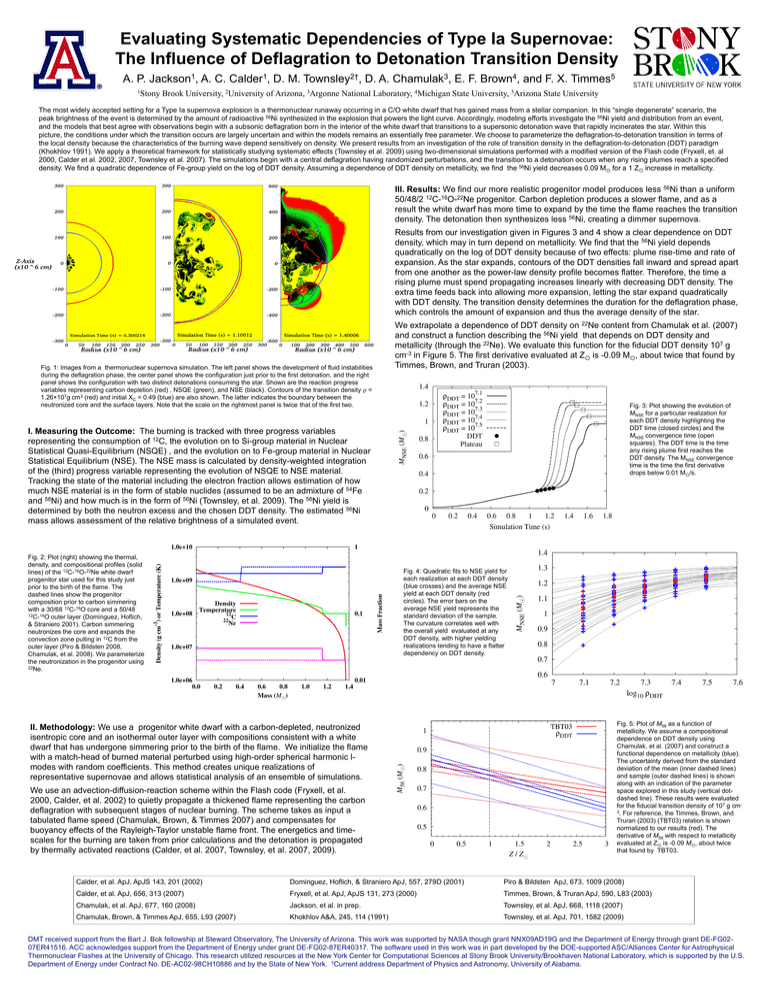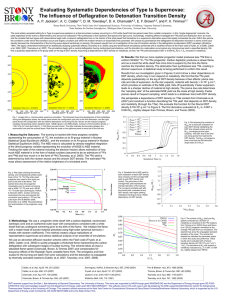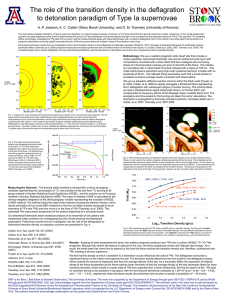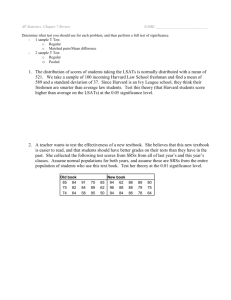Evaluating Systematic Dependencies of Type Ia Supernovae:
advertisement

Evaluating Systematic Dependencies of Type Ia Supernovae: The Influence of Deflagration to Detonation Transition Density A. P. Jackson1, A. C. Calder1, D. M. Townsley2†, D. A. Chamulak3, E. F. Brown4, and F. X. Timmes5 1Stony Brook University, 2University of Arizona, 3Argonne National Laboratory, 4Michigan State University, 5Arizona State University The most widely accepted setting for a Type Ia supernova explosion is a thermonuclear runaway occurring in a C/O white dwarf that has gained mass from a stellar companion. In this “single degenerate” scenario, the peak brightness of the event is determined by the amount of radioactive 56Ni synthesized in the explosion that powers the light curve. Accordingly, modeling efforts investigate the 56Ni yield and distribution from an event, and the models that best agree with observations begin with a subsonic deflagration born in the interior of the white dwarf that transitions to a supersonic detonation wave that rapidly incinerates the star. Within this picture, the conditions under which the transition occurs are largely uncertain and within the models remains an essentially free parameter. We choose to parameterize the deflagration-to-detonation transition in terms of the local density because the characteristics of the burning wave depend sensitively on density. We present results from an investigation of the role of transition density in the deflagration-to-detonation (DDT) paradigm (Khokhlov 1991). We apply a theoretical framework for statistically studying systematic effects (Townsley et al. 2009) using two-dimensional simulations performed with a modified version of the Flash code (Fryxell, et. al 2000, Calder et al. 2002, 2007, Townsley et al. 2007). The simulations begin with a central deflagration having randomized perturbations, and the transition to a detonation occurs when any rising plumes reach a specified density. We find a quadratic dependence of Fe-group yield on the log of DDT density. Assuming a dependence of DDT density on metallicity, we find the 56Ni yield decreases 0.09 M for a 1 Z increase in metallicity. III. Results: We find our more realistic progenitor model produces less 56Ni than a uniform 50/48/2 12C-16O-22Ne progenitor. Carbon depletion produces a slower flame, and as a result the white dwarf has more time to expand by the time the flame reaches the transition density. The detonation then synthesizes less 56Ni, creating a dimmer supernova. Results from our investigation given in Figures 3 and 4 show a clear dependence on DDT density, which may in turn depend on metallicity. We find that the 56Ni yield depends quadratically on the log of DDT density because of two effects: plume rise-time and rate of expansion. As the star expands, contours of the DDT densities fall inward and spread apart from one another as the power-law density profile becomes flatter. Therefore, the time a rising plume must spend propagating increases linearly with decreasing DDT density. The extra time feeds back into allowing more expansion, letting the star expand quadratically with DDT density. The transition density determines the duration for the deflagration phase, which controls the amount of expansion and thus the average density of the star. Fig. 1: Images from a thermonuclear supernova simulation. The left panel shows the development of fluid instabilities during the deflagration phase, the center panel shows the configuration just prior to the first detonation, and the right panel shows the configuration with two distinct detonations consuming the star. Shown are the reaction progress variables representing carbon depletion (red) , NSQE (green), and NSE (black). Contours of the transition density = 1.26×107g cm3 (red) and initial XC = 0.49 (blue) are also shown. The latter indicates the boundary between the neutronized core and the surface layers. Note that the scale on the rightmost panel is twice that of the first two. We extrapolate a dependence of DDT density on 22Ne content from Chamulak et al. (2007) and construct a function describing the 56Ni yield that depends on DDT density and metallicity (through the 22Ne). We evaluate this function for the fiducial DDT density 107 g cm-3 in Figure 5. The first derivative evaluated at Z is -0.09 M, about twice that found by Timmes, Brown, and Truran (2003). Fig. 3: Plot showing the evolution of MNSE for a particular realization for each DDT density highlighting the DDT time (closed circles) and the MNSE convergence time (open squares). The DDT time is the time any rising plume first reaches the DDT density. The MNSE convergence time is the time the first derivative drops below 0.01 M/s. I. Measuring the Outcome: The burning is tracked with three progress variables representing the consumption of 12C, the evolution on to Si-group material in Nuclear Statistical Quasi-Equilibrium (NSQE) , and the evolution on to Fe-group material in Nuclear Statistical Equilibrium (NSE). The NSE mass is calculated by density-weighted integration of the (third) progress variable representing the evolution of NSQE to NSE material. Tracking the state of the material including the electron fraction allows estimation of how much NSE material is in the form of stable nuclides (assumed to be an admixture of 54Fe and 58Ni) and how much is in the form of 56Ni (Townsley, et al. 2009). The 56Ni yield is determined by both the neutron excess and the chosen DDT density. The estimated 56Ni mass allows assessment of the relative brightness of a simulated event. Fig. 2: Plot (right) showing the thermal, density, and compositional profiles (solid lines) of the 12C-16O-22Ne white dwarf progenitor star used for this study just prior to the birth of the flame. The dashed lines show the progenitor composition prior to carbon simmering with a 30/68 12C-16O core and a 50/48 12C-16O outer layer (Dominguez, Hoflich, & Straniero 2001). Carbon simmering neutronizes the core and expands the convection zone pulling in 12C from the outer layer (Piro & Bildsten 2008, Chamulak, et al. 2008). We parameterize the neutronization in the progenitor using 22Ne. Fig. 4: Quadratic fits to NSE yield for each realization at each DDT density (blue crosses) and the average NSE yield at each DDT density (red circles). The error bars on the average NSE yield represents the standard deviation of the sample. The curvature correlates well with the overall yield evaluated at any DDT density, with higher yielding realizations tending to have a flatter dependency on DDT density. II. Methodology: We use a progenitor white dwarf with a carbon-depleted, neutronized isentropic core and an isothermal outer layer with compositions consistent with a white dwarf that has undergone simmering prior to the birth of the flame. We initialize the flame with a match-head of burned material perturbed using high-order spherical harmonic lmodes with random coefficients. This method creates unique realizations of representative supernovae and allows statistical analysis of an ensemble of simulations. We use an advection-diffusion-reaction scheme within the Flash code (Fryxell, et al. 2000, Calder, et al. 2002) to quietly propagate a thickened flame representing the carbon deflagration with subsequent stages of nuclear burning. The scheme takes as input a tabulated flame speed (Chamulak, Brown, & Timmes 2007) and compensates for buoyancy effects of the Rayleigh-Taylor unstable flame front. The energetics and timescales for the burning are taken from prior calculations and the detonation is propagated by thermally activated reactions (Calder, et al. 2007, Townsley, et al. 2007, 2009). Fig. 5: Plot of M56 as a function of metallicity. We assume a compositional dependence on DDT density using Chamulak, et al. (2007) and construct a functional dependence on metallicity (blue). The uncertainty derived from the standard deviation of the mean (inner dashed lines) and sample (outer dashed lines) is shown along with an indication of the parameter space explored in this study (vertical dotdashed line). These results were evaluated for the fiducial transition density of 107 g cm3. For reference, the Timmes, Brown, and Truran (2003) (TBT03) relation is shown normalized to our results (red). The derivative of M56 with respect to metallicity evaluated at Z is -0.09 M, about twice that found by TBT03. Calder, et al. ApJ, ApJS 143, 201 (2002) Dominguez, Hoflich, & Straniero ApJ, 557, 279D (2001) Piro & Bildsten ApJ, 673, 1009 (2008) Calder, et al. ApJ, 656, 313 (2007) Fryxell, et al. ApJ, ApJS 131, 273 (2000) Timmes, Brown, & Truran ApJ, 590, L83 (2003) Chamulak, et al. ApJ, 677, 160 (2008) Jackson, et al. in prep. Townsley, et al. ApJ, 668, 1118 (2007) Chamulak, Brown, & Timmes ApJ, 655, L93 (2007) Khokhlov A&A, 245, 114 (1991) Townsley, et al. ApJ, 701, 1582 (2009) DMT received support from the Bart J. Bok fellowship at Steward Observatory, The University of Arizona. This work was supported by NASA though grant NNX09AD19G and the Department of Energy through grant DE-FG0207ER41516. ACC acknowledges support from the Department of Energy under grant DE-FG02-87ER40317. The software used in this work was in part developed by the DOE-supported ASC/Alliances Center for Astrophysical Thermonuclear Flashes at the University of Chicago. This research utilized resources at the New York Center for Computational Sciences at Stony Brook University/Brookhaven National Laboratory, which is supported by the U.S. Department of Energy under Contract No. DE-AC02-98CH10886 and by the State of New York. †Current address Department of Physics and Astronomy, University of Alabama.








